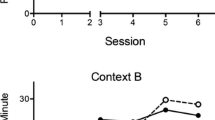Conclusions
-
1)
Elaboration of defensive instrumental conditioned reflexes proceeds much more readily than elaboration of analogous drinking conditioned reflexes.
-
2)
Differentiation with defensive reinforcement is elaborated more readily than with drinking reinforcement; in the first case it is done mainly owing to the increase of inhibition of the nonreinforced reflexes, in the second case, owing to the increase of the reinforced reflex. Differentiation with defensive reinforcement is manifested much better than with drinking reinforcement.
-
3)
A transition to reinforcement of both positive and negative signals degrades a previously elaborated differentiation but does not destroy the difference between positive and negative consolidated reflexes.
-
4)
Experiments with alternation of instrumental conditional reflexes with defensive reinforcement produce a high degree of discrimination and with drinking reinforcement poor discrimination.
-
5)
In the experiments with a stereotype of alternating signals with defensive reinforcement the animals reaction is linked mainly to the conditioned signal itself, while in the case of drinking reinforcement it is determined by a stereotype.
-
6)
Experiments decreasing the difference between positive and negative conditioned signals reveal higher discriminational abilities with defensive reinforcement than with drinking reinforcement.
Similar content being viewed by others
References
Anokhin, P. K. Biology and neurophysiology of the conditioned reflex (in Russian). Moscow,Medicine, 1968.
Asratyan, E. A., Physiology of central nervous system (in Russian). Moscow,Publication of Academy of Sciences, 1953.
Konorsky, J. Integrative brain activity (in Russian). M., 1970.
Muraviova, N. P. Normal and pathological stereotypes of conditional reflexes (in Russian). M.,Medicine, 1976.
Pavlov, I. P. 20 years experience of objective studies of animals higher nervous activity (behaviour) (in Russian). M.-L. Academy of Sciences Publishers, USSR, 1949.
Poliak, L. I. Internal organic states influence on differentiated motive conditioned reflexes of chimpanzee for various kinds of food (in Russian).Problems of Physiology, Kiev, Academy of Sciences USSR, 1953, N 4, 67.
Popova, E. I. Effectual expression of leading need (in Russian).Journal of the Higher Nervous Activity, 1973,23, N 1, 59.
Popova, E. I. Instrumental and classic reflexes in water reinforcement (in Russian).Journal of the Higher Nervous Activity, 1975,25, N 2, 288.
Popova, E. I. Instrumental drinking reflexes in thirst state and during drinking act (in Russian). Physiological mechanisms of movements. (L. S. Gambaryan, Ed). Erevan. Ac. of Sc. Arm. SSR, 1978, 137.
Simonov, P. V. Reflection theory and psychophysiology of emotions (in Russian). Moscow,Science, 1970.
Stchastny, A. I. Complex forms of anthropoids’ behaviour (in Russian), L.,Science, 1972.
Tapp, J. T.Reinforcement and Behavior. New York: Academic Press, 1969.
Urbakh, V. J. Biometric methods (in Russian). M.,Science, 1964.
Venetzian, G. L. Electrophysiological studies of the excitement in the conditioned irritator central structures after transforming the inhibition signal into a positive one (in Russian).Journal of the Higher Nervous Activity, 1966,16, N 6, 1113.
Weijnen, I. A. W. M., and Mendelson, J. (Eds).Drinking Behavior. Oral Stimulation, Reinforcement, and Preference. New York: Plenum Press, 1977.
Zewald, L. O. Dynamics of the differentiated inhibition limit in various functional rates (in Russian).Journal of the Higher Nervous Activity, 1964,14, N 2, 263.
Zielinski, K. Klassyficacja metod wytwarzania odruchow warunkowych.Acta Physiol Polon, 1976,27, N 5, Suppl. 13, 3.
Author information
Authors and Affiliations
Additional information
This article was published in the Soviet Union inThe Journal of Nervous Activity, 1981,31, 1217–1223.
Rights and permissions
About this article
Cite this article
Semaguin, V.N., Zukhar, A.V. Significance of reinforcement for differentiation of signals of instrumental conditional reflexes in rats. Pav. J. Biol. Sci. 18, 181–185 (1983). https://doi.org/10.1007/BF03019351
Issue Date:
DOI: https://doi.org/10.1007/BF03019351




